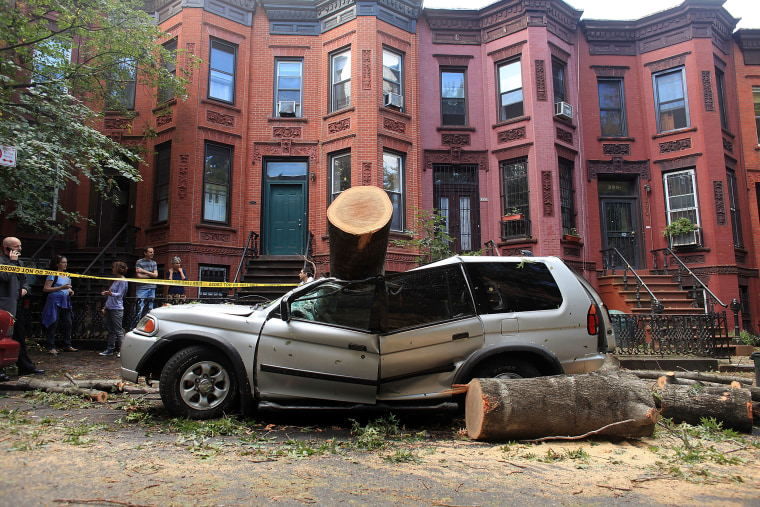A rare tornado warning was issued Tuesday for the New York City area, triggered by severe thunderstorms that rolled through the region. While it’s uncommon for twisters to hit major cities like New York, scientists say that may not always be the case.
There’s no special reason why tornadoes seem to miss big cities. It just comes down to chance. Densely populated urban areas such as Los Angeles, Chicago or New York are relatively small specks amid vast stretches of forests, mountains or otherwise rural regions.
“Cities are small targets,” said Victor Gensini, a climatologist at Northern Illinois University in DeKalb. “If you think of a dartboard, a dense urban area is really the double bull's-eye. It’s very rare for a downtown metro business district to get hit.”
But, as cities grow and developments spill beyond city limits, these areas become part of an “expanding bull's-eye” effect, as described by a 2015 study published in the magazine Weatherwise.
“There’s an enormous increase in vulnerability and exposure just due to population density,” Gensini said. “I could give numerous examples in Illinois, where I live, where tornadoes would have normally blown through corn fields, but now they’re going through urban areas.”
Though rare, tornadoes have hit big cities. In 1999, a strong tornado blew through Salt Lake City, causing one death and at least 81 injuries. In 2000, a tornado struck downtown Fort Worth, Texas, killing two people. And in 2008, a powerful tornado pummeled downtown Atlanta, killing one person and becoming the first on record to strike that city center.
“These are very low probability events, but if and when they occur, they will likely be devastating,” Gensini said.
Part of the danger of a tornado hitting an urban area is the amount of debris such a storm would generate.
“The big thing that you need to worry about is flying glass,” said Patrick Marsh, a meteorologist at the National Oceanic and Atmospheric Administration’s Storm Prediction Center in Norman, Oklahoma. “There’s a lot more glass in New York City than in Shawnee, Oklahoma, where I live.”
In cities like Chicago or New York City, there’s also a lot of tightly packed buildings, which could result in power outages that affect a greater percentage of the local population, he added.
But these increased risks don’t necessarily mean urban tornadoes will be more deadly.
“In big cities, a lot of structures are concrete or reinforced steel, so you have a lot of structures that the vast majority of tornadoes are not going to be able to penetrate,” Marsh said.
While tornadoes may not be drawn to metropolitan areas, scientists have found that different areas of the country could be affected by tornadoes in the future.
In October 2018, a paper co-authored by Gensini and published in the journal Nature showed that tornado outbreaks have been shifting slightly east over the past 40 years. The biggest increases were seen across most of the Midwest, and in northern Mississippi, northern Alabama, parts of Arkansas and Tennessee.
"These changes in the mid-South area are important because we have extremely vulnerable populations there, with a lot of people living in mobile homes," Gensini said. "The change we saw is one tornado per county per decade, so it's not a big trend, but given how rare tornadoes are, it's a significant upward increase."
The researchers are not yet sure what is driving this shift.
What is certain, however, is the best way to remain safe. An oft-repeated tip for tornado survival is to seek shelter in a basement, but Marsh said this is something of a myth.
“If you have a basement available, then that’s absolutely a good choice, but it’s one of the biggest pieces of misinformation out there that you need to be below ground to survive a tornado," he said.
Instead, people should try to take cover in a permanent, well-built — and ideally, reinforced — structure on the lowest floor, because winds in a tornado tend to be less violent closer to the ground, according to Marsh.
Then, he said, take cover as much as possible.
“The more walls that are standing between you and the outside — those walls will absorb most of the debris,” Marsh said.
With many cities across the U.S. dealing with changing population densities and the expanding bull's-eye effect, people should be mindful of the risks of extreme weather, no matter which region of the country they reside in, said J. Marshall Shepherd, director of the atmospheric sciences program at the University of Georgia in Athens.
“A lot of places that aren’t prone to tornadoes or aren’t experienced with extreme weather might not even know how to respond," Shepherd said, "but one message I have is that no matter where you live, you should think about what your plan of action is if there’s a future tornado.”
SIGN UP FOR THE MACH NEWSLETTER AND FOLLOW NBC NEWS MACH ON TWITTER, FACEBOOK, AND INSTAGRAM.


